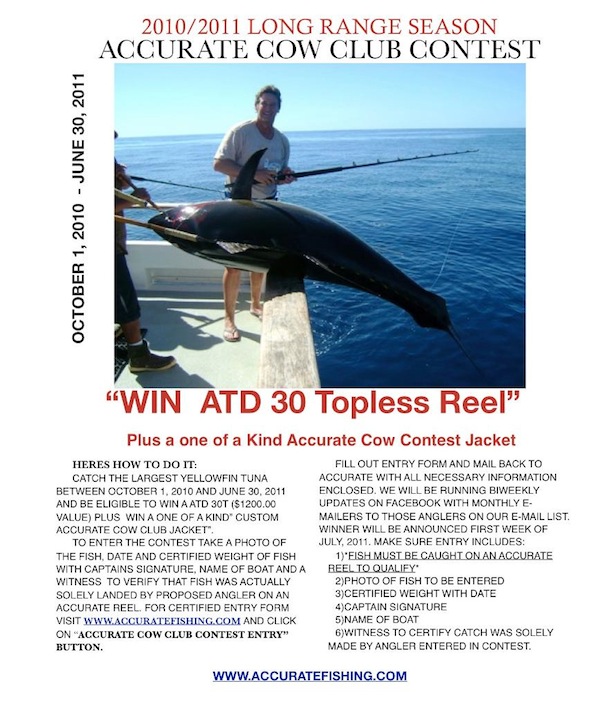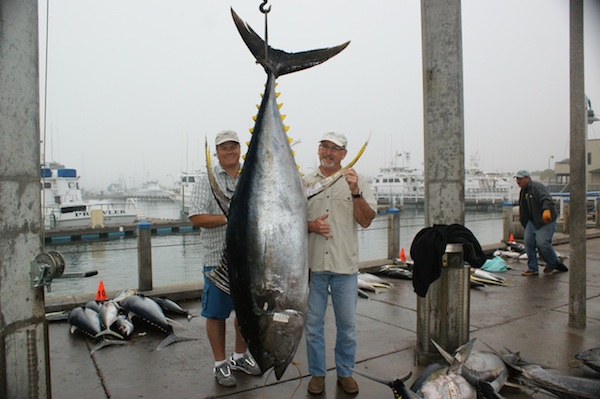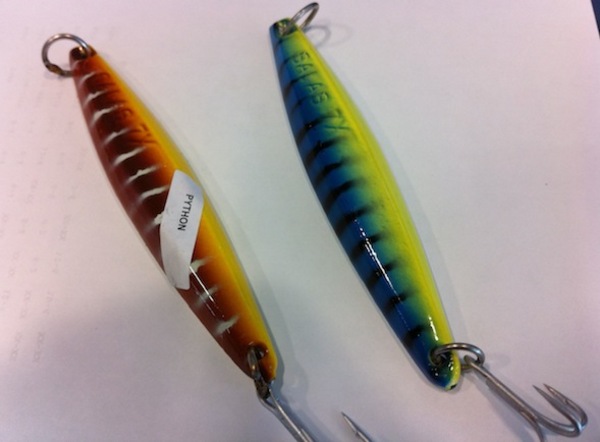Long Range Fish Report
From Sportfishing
From Sportfishing
Fish Report for 11-19-2010

Big fish catches usher in Accurate contest for free reel
11-19-2010
Rich Holland
Win a Topless 30 in Accurate Cow Club Contest
The cows are coming home and if you catch the biggest yellowfin tuna of the season (October 1, 2010 to June 30, 2011) on an Accurate reel you could be eligible to win an ATD 30 T reel, a value of $1200. Complete contest details can be found at www.accuratefishing.com.
The contest has some pretty basic angling rules: the catch has to be on an Accurate reel, it has to be a solo catch, the fish has to be weighed on a certified scale and the entry has to be signed by the captain of the boat and a witness who will attest to the fact the catch was "solely made by the angler".
Although the time frame encompasses what is traditionally the "long range season," and that's noted on the flyer, the promotional piece for the contest does not specify the catch must be on a long range vessel, although I would guess that to be the case.
The rules are definitely long range jackpot rules, but I reckon long rangers that weigh their fish aboard the boat, like the Royal Star, so as to process them right away, will have to make a choice between a heavier weight (and a chance at winning an Accurate reel) and better table fare, since any weight on a boat afloat is not certified. The scale can be certified, but the weight isn't unless you somehow find a stable platform like an island or pier.
Maybe the Accurate folks will only care if the fish is weighed in accordance to a boat's tradition, instead of the stricter standards of a true certified weight, which the IGFA demands.
Of course, the IGFA demands a lot, which is why I originally came up with the San Diego Top Ten Tuna list in the 90s, which recognized catches by a single angler made according to the customs of the long range fleet. I had the WON archives at my disposal back then, but even with in depth research the list still had to be published several times over the course of a year and a half before I stopped getting calls from across the country (literally from Boston to Hawaii) setting the list straight.
Other started to use the list, but when I saw it published elsewhere, I made sure I got credit. In the case of Chuck Garrison, who bagged it a couple times and sold pieces built around the list to local and national publications, I insisted on a cut of the take.
But it seemed a natural for Bill Roecker to use the list and I eventually told him he could take it over, although calling it "Bill Roecker's All Time Tuna List" isn't exactly what I envisioned.
I do have to say, though, the toughest part of the list to get right initially was the middle and the bottom. Back then a bunch of long rangers with 360-pound-class tuna were separated by a few pounds. Now quite a few have been bumped off the list and the 379.8-pound yellowfin caught by Greg Koonce on the Polaris Supreme's recent trip just bumped another.
But that's what records are for - to be beaten. And the reason for the list in the first place again became very apparent - since Koonce's fish has no chance of ever making it into the International Game Fish Association records. If you read my last post or other accounts of the catch, the fish broke free of the hook at the last second and only a lunging gaff shot saved the day.
In the section of the IGFA's International Angling Rules marked as "The following acts will disqualify a catch:" No. 14 is If a fish escapes before gaffing or netting and is recaptured by any method other than as outlined in the angling rules.
Many a tournament has been lost because of this rule, anglers having to watch as hundreds of thousands of dollars of fish slide into the deep. And let me say the rule is a good one, as are all the IGFA angling rules. Take a look at them and they present a fair standard for all fish to be judged against.
But we're long range fishermen and we only care how we stack up against each other - and the fish. IGFA rules are just rules, not laws. We have our own "jackpot" rules and they are often subjective to the point that at times "the decision of the captain is final."
We know the big fish taken aboard the long range fleet stand on their own merit. And the best of those stand above the rest.
I've attached the entire section from the International Angling Rules so you can decide for yourself whether it's worthwhile to break out the paperwork when you catch a big one.
The following acts will disqualify a catch:
1. Failure to comply with equipment or angling regulations.
2. The act of persons other than the angler in touching any part of the rod, reel, or line (including the double line) either bodily or with any device, from the time a fish strikes or takes the bait or lure, until the fish is either landed or released, or in giving any aid other than that allowed in the rules and regulations. If an obstacle to the passage of the line through the rod guides has to be removed from the line, then the obstacle (whether chum, floatline, rubber band, or other material) shall be held and cut free. Under no circumstances should the line be held or touched by anyone other than the angler during this process.
3. Resting the rod in a rod holder, on the gunwale of the boat, or any other object while playing the fish.
4. Handlining or using a handline or rope attached in any manner to the angler's line or leader for the purpose of holding or lifting the fish.
5. Shooting, harpooning, or lancing any fish (including sharks and halibuts) at any stage of the catch.
6. Chumming with or using as bait the flesh, blood, skin, or any part of mammals other than hair or pork rind used in lures designed for trolling or casting.
7. Using a boat or device to beach or drive a fish into shallow water in order to deprive the fish of its normal ability to swim.
8. Changing the rod or reel while the fish is being played.
9. Splicing, removing, or adding to the line while the fish is being played.
10. Intentionally foul hooking a fish.
11. Catching a fish in a manner that the double line never leaves the rod tip.
12. Using a size or kind of bait that is illegal to possess.
13. Attaching the angler's line or leader to part of a boat or other object for the purpose of holding or lifting the fish.
14. If a fish escapes before gaffing or netting and is recaptured by any method other than as outlined in the angling rules.
Meanwhile, all you have to do is catch the biggest tuna on an Accurate reel and be the only one to actively catch the fish and you could win the hottest piece of long range fishing machinery on the market. Good luck.
The cows are coming home and if you catch the biggest yellowfin tuna of the season (October 1, 2010 to June 30, 2011) on an Accurate reel you could be eligible to win an ATD 30 T reel, a value of $1200. Complete contest details can be found at www.accuratefishing.com.
The contest has some pretty basic angling rules: the catch has to be on an Accurate reel, it has to be a solo catch, the fish has to be weighed on a certified scale and the entry has to be signed by the captain of the boat and a witness who will attest to the fact the catch was "solely made by the angler".
Although the time frame encompasses what is traditionally the "long range season," and that's noted on the flyer, the promotional piece for the contest does not specify the catch must be on a long range vessel, although I would guess that to be the case.
The rules are definitely long range jackpot rules, but I reckon long rangers that weigh their fish aboard the boat, like the Royal Star, so as to process them right away, will have to make a choice between a heavier weight (and a chance at winning an Accurate reel) and better table fare, since any weight on a boat afloat is not certified. The scale can be certified, but the weight isn't unless you somehow find a stable platform like an island or pier.
Maybe the Accurate folks will only care if the fish is weighed in accordance to a boat's tradition, instead of the stricter standards of a true certified weight, which the IGFA demands.
Of course, the IGFA demands a lot, which is why I originally came up with the San Diego Top Ten Tuna list in the 90s, which recognized catches by a single angler made according to the customs of the long range fleet. I had the WON archives at my disposal back then, but even with in depth research the list still had to be published several times over the course of a year and a half before I stopped getting calls from across the country (literally from Boston to Hawaii) setting the list straight.
Other started to use the list, but when I saw it published elsewhere, I made sure I got credit. In the case of Chuck Garrison, who bagged it a couple times and sold pieces built around the list to local and national publications, I insisted on a cut of the take.
But it seemed a natural for Bill Roecker to use the list and I eventually told him he could take it over, although calling it "Bill Roecker's All Time Tuna List" isn't exactly what I envisioned.
I do have to say, though, the toughest part of the list to get right initially was the middle and the bottom. Back then a bunch of long rangers with 360-pound-class tuna were separated by a few pounds. Now quite a few have been bumped off the list and the 379.8-pound yellowfin caught by Greg Koonce on the Polaris Supreme's recent trip just bumped another.
But that's what records are for - to be beaten. And the reason for the list in the first place again became very apparent - since Koonce's fish has no chance of ever making it into the International Game Fish Association records. If you read my last post or other accounts of the catch, the fish broke free of the hook at the last second and only a lunging gaff shot saved the day.
In the section of the IGFA's International Angling Rules marked as "The following acts will disqualify a catch:" No. 14 is If a fish escapes before gaffing or netting and is recaptured by any method other than as outlined in the angling rules.
Many a tournament has been lost because of this rule, anglers having to watch as hundreds of thousands of dollars of fish slide into the deep. And let me say the rule is a good one, as are all the IGFA angling rules. Take a look at them and they present a fair standard for all fish to be judged against.
But we're long range fishermen and we only care how we stack up against each other - and the fish. IGFA rules are just rules, not laws. We have our own "jackpot" rules and they are often subjective to the point that at times "the decision of the captain is final."
We know the big fish taken aboard the long range fleet stand on their own merit. And the best of those stand above the rest.
I've attached the entire section from the International Angling Rules so you can decide for yourself whether it's worthwhile to break out the paperwork when you catch a big one.
The following acts will disqualify a catch:
1. Failure to comply with equipment or angling regulations.
2. The act of persons other than the angler in touching any part of the rod, reel, or line (including the double line) either bodily or with any device, from the time a fish strikes or takes the bait or lure, until the fish is either landed or released, or in giving any aid other than that allowed in the rules and regulations. If an obstacle to the passage of the line through the rod guides has to be removed from the line, then the obstacle (whether chum, floatline, rubber band, or other material) shall be held and cut free. Under no circumstances should the line be held or touched by anyone other than the angler during this process.
3. Resting the rod in a rod holder, on the gunwale of the boat, or any other object while playing the fish.
4. Handlining or using a handline or rope attached in any manner to the angler's line or leader for the purpose of holding or lifting the fish.
5. Shooting, harpooning, or lancing any fish (including sharks and halibuts) at any stage of the catch.
6. Chumming with or using as bait the flesh, blood, skin, or any part of mammals other than hair or pork rind used in lures designed for trolling or casting.
7. Using a boat or device to beach or drive a fish into shallow water in order to deprive the fish of its normal ability to swim.
8. Changing the rod or reel while the fish is being played.
9. Splicing, removing, or adding to the line while the fish is being played.
10. Intentionally foul hooking a fish.
11. Catching a fish in a manner that the double line never leaves the rod tip.
12. Using a size or kind of bait that is illegal to possess.
13. Attaching the angler's line or leader to part of a boat or other object for the purpose of holding or lifting the fish.
14. If a fish escapes before gaffing or netting and is recaptured by any method other than as outlined in the angling rules.
Meanwhile, all you have to do is catch the biggest tuna on an Accurate reel and be the only one to actively catch the fish and you could win the hottest piece of long range fishing machinery on the market. Good luck.
Rich Holland's Roundup
< Previous Report Next Report >

LongRangeSportfishing.net © 2025. All Rights Reserved.
Website Hosting and Design provided by TECK.net
Website Hosting and Design provided by TECK.net

